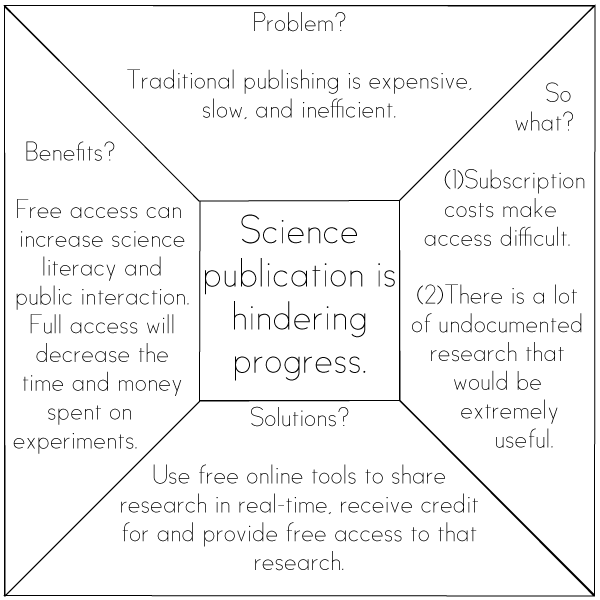The message box isn’t typically something you’d share with the public, but in the interest of education I thought I’d share mine so everyone can see what the goal of the message box is.
My message box revolves around open notebook science and here is the final form:

But it didn’t start there. I’ve been thinking about what my message should be for the better part of a couple of days. Then I went into Google Docs and started writing commentary for each section. Finally I whittled it down to what you see above. Since I’m an open notebook scientist, it only makes sense for me to show you my methods, which you can see here.
If you feel comfortable, please share your message box in comments below. To make it simple, just use a similar format to what I did in the Google Doc:
- Issue
- Problem?
- So What?
- Solution?
- Benefits?
And I welcome any suggestions anyone has about my message box.



Osteoporosis Medications and Unusual Fractures Message Box
Issue: Are osteoporosis medications causing fractures instead of preventing them?
Problem: Some patients on a specific type of osteoporosis medication are suffering from unusual fractures in their thigh bones (Atypical Femur Fractures — AFF). Need to study these atypical fractures and see what’s going on at the level of the bone – are there differences, structurally or chemically, in the bones of these patients compared to those who have osteoporosis but don’t have these atypical fractures. How do we treat patients with atypical fractures? Can they be prevented?
So What: Osteoporosis medications prevent debilitating fractures and these unusual AFFs are very rare (1 in 1000 women who have been taking these medications for 5 years or more). Patients can get swayed by media misinformation and stop taking their medications.
Solution: Patients who have AFF can join our research study or a research study in their area, if possible. Patients on these medications for longer than 5 years can talk to their physician(s) and possibly change medications if they are concerned.
Benefits: Better understanding leads to better treatment.
Issue: Common treatments for chronic pain are only partially effective.
Problem?
Inflammation makes our pain receptors temporarily more sensitive, but sometimes they stay sensitive
after inflammation is gone. Available treatments for chronic pain don’t treat pain receptor’s sensitivity.
So what?
100 million Americans suffer chronic pain. Chances are that you will need a pain treatment during your life.
Solutions?
Establish treatments that affect pain receptors directly, reducing side effects. Learn what are the causes of chronic pain and stop them before pain becomes permanent.
Benefit?
Understanding pain receptor sensitization helps us create treatments for chronic pain, but also helps to understand its causes and perhaps learn how to stop it before it becomes chronic.
Message box for a local journalist
Issue: Natural gas powered vehicles have the potential to be a more environmentally friendly alternative to gasoline or diesel powered vehicles.
Problem?
1. 28% of Canada’s greenhouse gas emissions are from transport.
2. Natural gas powered vehicles, an environmentally friendlier alternative to gasoline or diesel vehicles, emit methane, which is a strong greenhouse gas.
So what?
In 2010 Canada committed to significantly reducing its greenhouse gas emissions. It is important to take steps to meet this goal and protect the environment.
Solutions?
Develop new methods to break down methane inside the vehicle before it is released into the atmosphere.
Benefits?
1. More environmentally friendly vehicles on our roads
2. Westport, a world leader in natural gas vehicles, has its headquarters in Vancouver, BC (benefits local economy).
Here’s my message box:
Maintaining Native Ants Message Box
Issue: invasive ants are destructive and disruptive.
So What?: Invasive ants reproduce and disperse more effectively making them very difficult to control. They often have nasty stings, bites, and may cause allergic reactions which may affect people and livestock. They decimate native ants and other organisms. They are often associated with human activity and may encroach on these areas, for instance getting into electrical wiring.
Problems: The presence of invasive ants causes at least 3 kinds of loss: economic loss; environmental/ecosystem function loss; and natural beauty/recreational land use loss.
Solution: Maintain native ants by maintaining native habitats including the use of native plants in landscapes and gardens. Doing so effectively excludes invasive species which thrive in the artificial climates we make for the non-native plants.
Benefits: no need to micro-manage land – takes care of itself, so to speak
reduction in economic loss and inputs to maintain soil fertility, etc.
benefits to other wildlife as well – monarch butterfly, horned lizard, etc.
Thank you all for sharing these – it’s a great help to those of us struggling to do our own message boxes without someone here to help in person! I appreciate it.